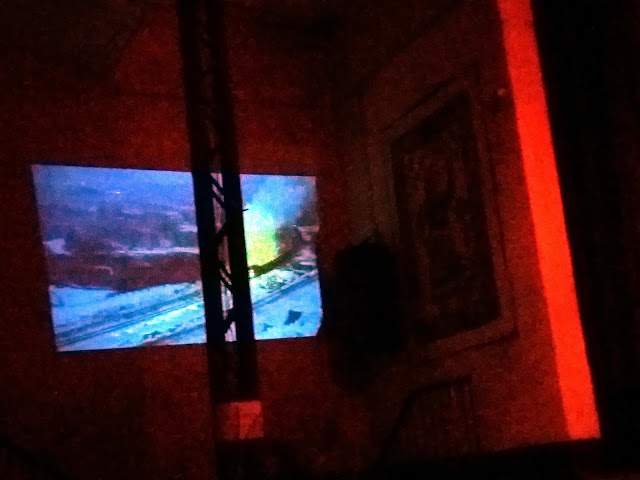An interior dilemma - to kill or not to kill?
The play 'Apne Paraye' is a psychological engineering that works at a very delicate level of attitudinal construct. A young boy is committed to change the stinking system though in a perverse manner. He has chosen a path of violence. To kill some people is his perceived way to pressurise the power for welfare of large masses. And the biggest obstacle in his path is the person whom he adores the most. The play generates at the interface of the two most powerful impulses in a civil man- the impulse for ensuring goodness for masses and the impulse to save the most adored person in the life. The drama narrates beautifullycthe ideological fight of approaches between two truly committed persons exactly for the same welfare cause of broader masses. A specifically motivated person is often ready to sacrifice the lives of the innocent people for greater causes though he is broken when he sees that the people being sacrificed is his own adored ones.
Radheshyam is a very honest middle-class person having an understanding wife and lovely daughter along with a obedient and disciplined younger brother. At the outset, the routine problems of a lay middle class family come into light that are taken mildly by Radheshyam and his wife. But the younger brother Manoj thinks the problems are the outcome of mismanaged system that needs to be corrected. He is no way ready to tolerate the sorriness of the system. He plans to make those in power mend the ways.
A comedy scene intervenes to energise the audience who have to witness a greater conflict later. A man comes from a village and offers his daughter to marry the younger brother Manoj in this family. As Manoj has certain engagement with revolutionary causes he feigns as if a lunatic. The viewers laugh does not end here the situation dips into bizarreness when the girl's father is still not desisting from his offer. Transpiring all this, Radheshyam starts to enumerate the demerits of his younger brother and admits that he would not match the daughter of the gentleman. But the visitor says that his daughter is also like this boy in every respect and so will match. On this the people were seen polling and tossing.
And just after the exit of the visitor the real drama starts. A friend of Manoj comes and through eavesdropping Radheshyam is able to smell a rat. He comes to know abouot their plan as devastating as bombing the railway track just before the arrival of train at 2.45 AM. He tries to convince Manoj to drop this destructive idea. But Manoj is comitted to his cause so that the government hears the demands of his group. A heated conversation ensues and ultimately Radheshyam threatens that if Manoj is adamant on killing large number of innocent passengers then one of the dead body found will be that of him (Radheshyam). Manoj faces a great dilemma but still stick to his chosen path. He sleeps so that he may arise at 2.45AM. A nightmare is experrienced by him in which the life of his most adorable person that is his elder brother Radheshyam is at stake. He wakes up with a jitter and thinks what a nonsense he is going to wreck up! Such a huge loss of life to public! And going to cause the death of his own elder brother who has nurtured him as a pure hearted loving father. But still the instinct of higher revolutionary goals has been keeping a grip of his mind and he is unable to chalk out how tol deal with the people of his group.
At this the elder brother comes to his rescue and says that he has convinced all of his friends to drop the idea of destruction and adopt the peaceful means of resistance. Now the train passes at 2.45AM on the track peacefully and the whole family relax.
A very relevant issue is raised by Satish Prasad Sinha in his nice script. The characters of Radheshyam, wife, daughter and Manoj and others have been crafted adeptly by him. The motif of the script is manifest in the last scene when Radheshyam and Manoj are engaged in ideological debate on the means of resistance. This debate might have given more space by the script-writer/ or director. Shailesh did his job with commendable ability and actors did justice with the characters. Especially Radheshyam his wife and the little daughter left good impression. Manoj acted as directed by the director but sometimes he looked doing more than required. His friend and other actors presented good acting. Navin Kumar, Amool, Manikant Chaudhary, Sushma Sinha, Bharti Narayan, Krishna Lal, Om Kakpur, Pihu, Sanjay Kishore, Narayan Pandey, Subhash Chandra and Roshan were on-stage and did well.
Ritesh Parmar was on lights and Ashok Ghosh did the make-up of the actors. The experiment of motion picture on the screen on protruded upper part of side corner of the stage was marvelous. it gave a feel as if train really passes by on some nearby track from the house on the stage. Also the set design succeeded in creative a real ambiance of inside house.
The scriipt-writer, directors, actors and back stage artists deserve compliments.
..................
Review by - Hemant Das 'Him'
E-mail- hemantdas_2001@yahoo.com
Photographs by - Binay Kumar
Email of the editors of the blog- editorbiharidhamaka@yahoo.com























No comments:
Post a Comment
अपने कमेंट को यहाँ नहीं देकर इस पेज के ऊपर में दिये गए Comment Box के लिंक को खोलकर दीजिए. उसे यहाँ जोड़ दिया जाएगा. ब्लॉग के वेब/ डेस्कटॉप वर्शन में सबसे नीचे दिये गए Contact Form के द्वारा भी दे सकते हैं.
Note: only a member of this blog may post a comment.